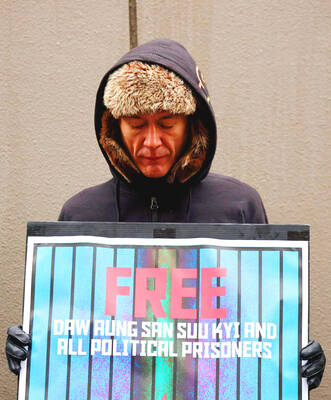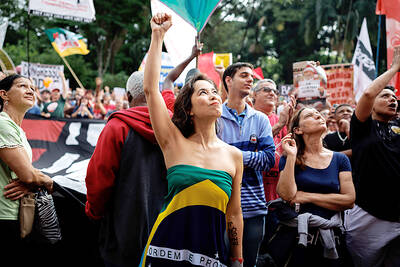Before taking a shot, Ukrainian sniper Andriy buries his face in a foldout mat, breathing slowly and deliberately.
“I need to be completely relaxed, to find a place where I will not move the rifle when I pull the trigger,” he said. “I don’t think about anything. It’s a kind of vacuum.”
In a semicircle around his head are boxes of bullets, printouts of charts, a heavy-duty stapler and a roll of tape. Strapped to his wrist is a monitor, which is the shape of a jewelry box. It is a ballistics calculator to factor in the wind and other surrounding conditions. Bees persistently circling his head and scope are ignored. After a long pause, he says the word “shot” in Ukrainian.

Photo: AP
The sound of the discharge produces a reflexive jolt in people unaccustomed to war.
Six months ago, the noise might have startled Andriy, who had moved to western Europe to pursue a career in engineering. His experience resembles that of many Ukrainians who returned home to the war, abruptly pulled from civilian life to embrace fighting methods — modern, but also makeshift — that have contested the Russian military.
Andriy is from Bucha, a district near Kyiv’s airport that was hammered during the Russian advance.
Hundreds of civilian killings took place there, the bodies found in mass graves or left lying where they were shot in what the UN described as potential war crimes.
Tall and with a good command of English, the sniper spoke to reporters while practicing alone at an informal firing range near Kyiv, hoping to resolve some issues with his weapon through hours of trial and error before his next deployment.
He asked only to be identified by his first name and that some details of his civilian life remain private.
Andriy scrambled home, taking a flight to Budapest and arranging a 1,200km overland route that included paying “a big amount of money” to a driver willing to take a risky journey eastward.
Within a few days he had joined the ferocious fight around Kyiv, adopting the war nickname “Samurai.”
He bought his own gear and a US-made rifle, and began receiving training from a special forces instructor, connected through friends in the military.
“Early in the morning on Feb. 24, I received a call from my mother. She lives in Bucha and told me the war had started. She could hear helicopters, airplanes, bombing and explosions. I decided to return,” he said.
While not allowed to discuss any specifics of his operational activity, Andriy described Ukraine’s military as a force that prides itself on flexibility, harnessing a wide range of skills from its personnel to become more versatile in combat.
Snipers, he said, are often used to spot Russian military positions for artillery targeting.
“I have also gained experience in tactical medicine, with drones and shooting with assault rifles,” he said.
Military specialists are encouraged to learn new skills and even find their own equipment, with Western suppliers still delivering to Ukraine in a private market that is monitored by the army.
To protect his hearing, Andriy acquired a set of hunter’s headphones that suppress the noise from his rifle while amplifying voices.
“You really need these,” he said.
Russia has more than doubled the territory it controls in Ukraine since launching the invasion in February, to about 20 percent of the country, but Andriy shares the optimism of many fellow Ukrainians that victory will be possible after the winter.
“I think with the help of our friends in Europe and the United States that we can push them out of our territory,” he said.
His desire to become a sniper came from a familiarity with hunting rifles, common in Ukraine, and playing the role of a distance shooter in video games.
He said that his goal at war is “to return to my home, to my family.”
“No one of us wanted to be a warrior, a shooter, a sniper,” he said. “It’s just a necessity to be here now and do what we’re doing here.”
“I don’t know how to explain this: I don’t like to kill people,” he said. “It’s not something you want to do, but it’s something you have to do.”

The Burmese junta has said that detained former leader Aung San Suu Kyi is “in good health,” a day after her son said he has received little information about the 80-year-old’s condition and fears she could die without him knowing. In an interview in Tokyo earlier this week, Kim Aris said he had not heard from his mother in years and believes she is being held incommunicado in the capital, Naypyidaw. Aung San Suu Kyi, a Nobel Peace Prize laureate, was detained after a 2021 military coup that ousted her elected civilian government and sparked a civil war. She is serving a

China yesterday held a low-key memorial ceremony for the 1937 Nanjing Massacre, with Chinese President Xi Jinping (習近平) not attending, despite a diplomatic crisis between Beijing and Tokyo over Taiwan. Beijing has raged at Tokyo since Japanese Prime Minister Sanae Takaichi last month said that a hypothetical Chinese attack on Taiwan could trigger a military response from Japan. China and Japan have long sparred over their painful history. China consistently reminds its people of the 1937 Nanjing Massacre, in which it says Japanese troops killed 300,000 people in what was then its capital. A post-World War II Allied tribunal put the death toll

‘NO AMNESTY’: Tens of thousands of people joined the rally against a bill that would slash the former president’s prison term; President Lula has said he would veto the bill Tens of thousands of Brazilians on Sunday demonstrated against a bill that advanced in Congress this week that would reduce the time former president Jair Bolsonaro spends behind bars following his sentence of more than 27 years for attempting a coup. Protests took place in the capital, Brasilia, and in other major cities across the nation, including Sao Paulo, Florianopolis, Salvador and Recife. On Copacabana’s boardwalk in Rio de Janeiro, crowds composed of left-wing voters chanted “No amnesty” and “Out with Hugo Motta,” a reference to the speaker of the lower house, which approved the bill on Wednesday last week. It is

FALLEN: The nine soldiers who were killed while carrying out combat and engineering tasks in Russia were given the title of Hero of the Democratic People’s Republic of Korea North Korean leader Kim Jong-un attended a welcoming ceremony for an army engineering unit that had returned home after carrying out duties in Russia, North Korean state media KCNA reported on Saturday. In a speech carried by KCNA, Kim praised officers and soldiers of the 528th Regiment of Engineers of the Korean People’s Army (KPA) for “heroic” conduct and “mass heroism” in fulfilling orders issued by the ruling Workers’ Party of Korea during a 120-day overseas deployment. Video footage released by North Korea showed uniformed soldiers disembarking from an aircraft, Kim hugging a soldier seated in a wheelchair, and soldiers and officials